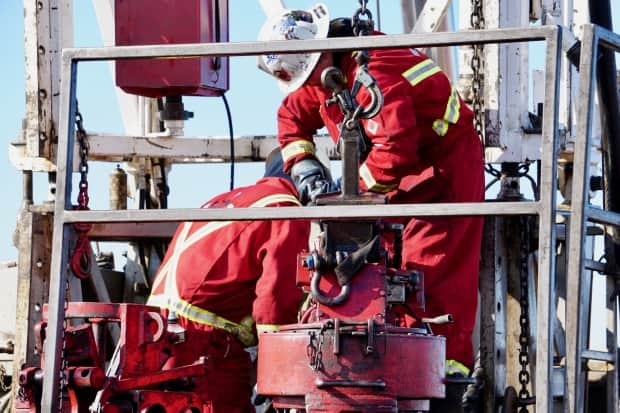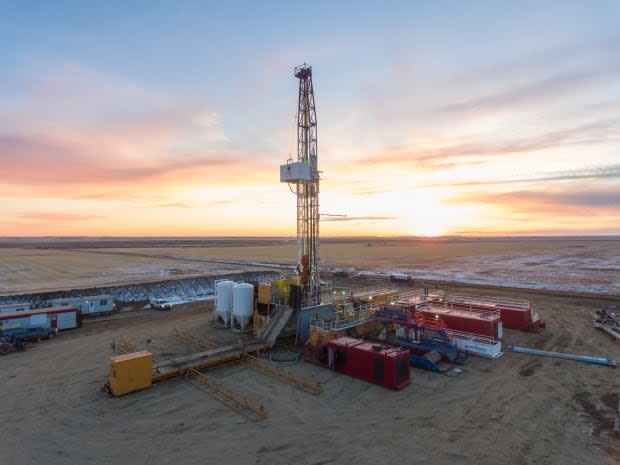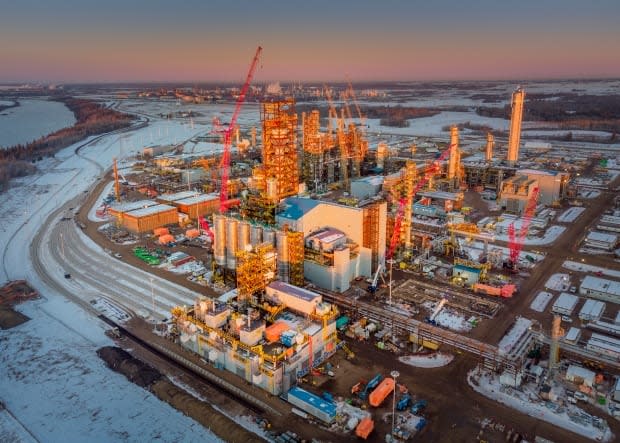Alberta's oil and gas workers wrestle with layoffs and an uncharted future

Growing up in Scotland, Jim Stirling chose a life in petroleum engineering rather than down in a mine, escaping the tumultuous decline of the British coal industry in the 1980s.
It led him to Canada, where he built a career tackling complex projects for major oil companies, from offshore exploration to carbon capture and storage. He took pride in being among the relative few able to do such work.
These days, however, Stirling is among the many oil and gas workers who've lost their jobs in the last seven years. He now runs his own consultancy while looking for work, but the job market has been rough.
"I was in my early mid-50s when I got laid off, and that's the wrong age to be looking for new employment," said Stirling, who was part of a wave of job cuts in the sector in 2015.
"And more senior positions had been more or less wiped out just because there was no real large-scale development ongoing."
Amid global efforts to transition away from fossil fuels, Alberta is not only being challenged to help put oil and gas workers back to work but to carve out a future in a low-emissions world that supports employment and communities for decades to come.

Industry and workers in transition
At the end of 2013, before oil prices began a long slide the following year, more than 171,000 people in Alberta were directly employed by the oil and gas industry, according to labour force statistics compiled by PetroLMI. This past February, it was fewer than 135,000.
According to PetroLMI, there were more than 15,500 workers in the oil and gas sector actively looking for employment last month.
"We talk about them as statistics, but they're people; they're family members," said labour expert Janet Lane at the Canada West Foundation, a public policy think tank in Calgary.

Improving energy prices have raised hopes for the kind of spending that will put people to work, especially if fuel demand soars as the pandemic abates.
But the recent cancellation of the proposed Keystone XL pipeline cost a 1,000 pipeline workers, their jobs and there's ongoing consolidation within the sector. Cenovus's takeover of Husky Energy, for example, is expected to produce as many as 2,100 layoffs.
Advances in technology mean more can also be done with fewer people.
While the oilpatch remains an economic force in Alberta, it's an industry facing great change.

Lane said it's still taking some time for people to understand many of those jobs aren't coming back and, when they do, they may not be the same jobs or might come with lower salary.
While there's still going to be work in the oilpatch for a long time, she said, those who have been unemployed for a few years now are probably not returning.
So, what are their options?
Tech ambitions
Jobs in the technology sector are often touted as one possible answer, and there are opportunities for those who can make the transition, including with companies working in fields such as financial services, agriculture and energy.
It'll take not just opportunity but training, and it appears there's a big appetite for both.
When Calgary Economic Development launched a $1.5-million pilot program last year to train former oil and gas workers for the tech sector, it received 1,400 applications for 100 spots.
Many see government investment in upgrading skills and retraining as key.

But governments will also have to keep diversifying the economy to help create new opportunities, said Mark Kopec, a former oilpatch engineer.
Kopec chose to leave the sector four years ago in his 30s to pursue a career as a software developer, deciding to uproot from Calgary temporarily to immerse himself in training in Silicon Valley. It also meant going from being a senior engineer to starting fresh in the junior ranks.
He's glad he made the move, landing a good job shortly after returning to Calgary. Still, he agrees that such changes aren't going to be easy for everyone.
"A lot of people feel most comfortable in what they've done well at; it's tough to make that change," Kopec said. "And especially in your mid-30s, going into a tech career, which felt like a young person's game. It's scary."
Early days for emerging sectors
When reservoir engineer Januar Wirawan was laid off by a major oil company in October 2019, his first instinct was to find another job within the sector where he'd built his career.
It was the first time in his working life that he didn't "bounce back better."
"I was looking for another position like the one that I had," he said. "That's where I got stuck. I was looking for a reservoir engineering position in oil and gas. And I couldn't find anything."

He had to learn to market the soft skills he'd developed, such as leadership and mentoring, and turned to an outplacement firm, Higher Landing, for help.
Wirawan ultimately found success — hired in February by a Calgary company that's working on producing hydrogen from oil fields while keeping the emissions below ground.
"I made the first step," said Wirawan, who'll be 55 this year. "I got this job, and now, the next phase is trying to contribute to this industry."
Wirawan is an example of someone who found work in one of the sectors focused on transitioning away from fossil fuels to other energy sources and reducing greenhouse gas emissions.
Significant wind and solar projects and geothermal energy development that are underway could provide job opportunities for traditional oil and gas workers.
But labour experts say when politicians or others suggest fossil fuel workers should simply move into "green" energy jobs, they misunderstand the complexities.
"We have huge potential with our oil and gas workforce to support the overall energy transition, but we're in early days, and that's going to have to mature," said Pat Hufnagel-Smith, a labour market consultant in Calgary.
Potential areas for growth include lithium, hydrogen development and helium.

While there are a lot of opportunities, she said, some of those sectors are still emerging, and it will take time to prove out which ones are going to be economically feasible.
"The economy is transitioning. The energy ecosystem is transitioning," Hufnagel-Smith said. " At the same time, we're trying to deal with a workforce that's transitioning [that] doesn't necessarily have the time or want to wait until those sectors get some traction."
Jobs are also expected to be created in the environmental sector, driven by investment in clean technology, emissions reduction and renewable energy.
Eco Canada, a national human resource organization based in Calgary, forecast in September that the net number of openings in that sector — including new jobs and replacement demand — could top 44,000 in Alberta by 2029.
Nationally, it expects there will be 233,500 net job openings in the environmental sector over that period.
The reclaiming of old oil and gas wells, in which Ottawa invested $1.7 billion last year, also offers job opportunities.
Hopes for the oilpatch
Some Albertans will continue to look to the oil and gas sector to drive both the economy and employment, much as it has done for decades. They'll say the oilpatch has had to reinvent itself before.
In addition to expectations for a post-COVID surge in fuel demand, there's optimism about export pipelines to the West Coast for both oil and liquefied natural gas.

A number of oil and gas companies have pledged to reach net-zero emission by 2050 — promises that'll require the focus, money and people with the expertise to achieve it.
To that end, some are looking to investments in carbon capture and storage to be the game changer for the sector that Premier Jason Kenney believes it can be, though not everyone sees it that way.
Others see big potential in blue hydrogen from natural gas as well as the petrochemical sector, which the government wants to grow dramatically by 2030.
Planning for an energy transition
Talk of the energy transition, however, appears only to be growing more urgent, particularly as U.S. President Joe Biden joins efforts to combat climate change.
As part of an international panel discussion on the energy transition last Tuesday, Canada's natural resources minister said the global effort to lower emissions is underway. But Seamus O'Regan said the world won't become oil-free overnight and it's incumbent upon governments to make sure traditional energy workers aren't left behind.
"Our energy workers here in this country, out in Alberta and Saskatchewan, in two generations figured out how to get oil out of sand," O'Regan said. "We need that same ingenuity and determination and work ethic now to lower emissions."

Economist Jim Stanford, director of the Centre for Future Work, a progressive think tank based in Vancouver, B.C., said what the government should do is make a plan to phase out the fossil fuel sector that prioritizes workers and communities.
"We aren't doing any favours for fossil fuel workers by pretending this [transition] isn't happening, and I think all Canadians owe a debt to the fossil fuel workers who have been working diligently in this industry," said the former policy director for Unifor, Canada's largest private sector union.
In a recent report for the advocacy group Environmental Defence, he suggested a series of focused support measures as part of a planned phase-out of the sector over 20 years, including incentives for early retirement, retraining and strong regional development and diversification strategies.
"If we identify the climate transition and the energy transition as a national priority, then we should be putting resources in it from all levels of government in Canada, and we can focus it on those communities that need the help the most," Stanford said.
Looking to the future
Thinking about his own future, engineer Stirling can spot the opportunity for better days in the areas he's targeting for employment, such as carbon capture and storage.
"In the same way that we're developing technologies to handle climate change, we need to be developing skill sets that do the same and skill sets that address future industrial needs."
In the meantime, he said it doesn't hurt to be a Calvinist Scotsman.
"I've kind of tended to be able to be careful with my money," Stirling said. "I'm just having to be a lot more careful with my money than I thought."


